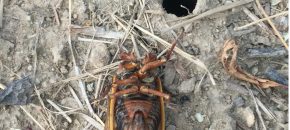Verticillium wilt is a common soil-borne fungal pathogen that once it has infested soil can remain for a very long time. Verticillium wilt is caused by either Verticillium albo-atrium or Verticillium dahlia and has a wide host range (over 200 plant species). Both pathogens can survive (overwinter) as microsclerotia in the soil. Verticillium wilt prefers […]
Continue reading...Preparing for Anthracnose and Alternaria Leaf Blights in Cucurbit Crops
Anthracnose and Alternaria leaf blight can become problematic in cucurbit crops during long periods of wet, humid weather. Both can cause significant losses if not controlled properly. With the production season in full swing, now is a good time to review a few of these important diseases.
Continue reading...Cicadas Are Here and Fruit IPM for 5/26/21

Cicadas are Here, There and Everywhere (Depending where you are): 17 year cicadas began emergence last week. These insects while a marvel in the insect world, are also capable of doing considerable damage to young fruit trees, grape vines, and blueberry bushes. After mating they begin to deposit their eggs in slits along small diameter […]
Continue reading...Immediate potential for boxwood blight in many parts of NJ over the next 4 days
Breaking- Due to the potential for rainfall and high humidity levels, there is an immediate risk of boxwood blight infections in many parts of New Jersey. Be mindful that even though we have had very little precipitation in the state as of late, we are well within the boxwood blight growth range and prior cover-sprays […]
Continue reading...Stinger herbicide 24(c) Special Local Need label renewed until 2025 for use on Highbush Blueberries

The NJDEP informed us last Friday that the 24(c) Special Local Need label for use of Stinger (clopyralid) herbicide in highbush blueberries has been renewed for the 5 years with an expiration date set on December 31, 2025. This is a really good news for the New Jersey Blueberry Industry as Stinger is a crucial […]
Continue reading...Keep Up the Customer Communication!
Now that the dates have been set for the lifting of the face covering requirements indoors and social distancing requirements indoors and out (May 28th) farms have decisions to make. What will you require of your customers while on your property? How will you handle customers who expect more or less when it comes to […]
Continue reading...